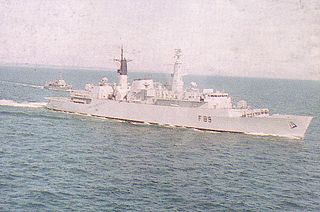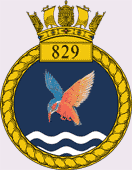
The Royal Navy (RN) is the naval warfare force of the United Kingdom, British Overseas Territories and Crown Dependencies, and a component of His Majesty's Naval Service. Although warships were used by English and Scottish kings from the early medieval period, the first major maritime engagements were fought in the Hundred Years' War against France. The modern Royal Navy traces its origins to the early 16th century; the oldest of the UK's armed services, it is consequently known as the Senior Service.

HMS Cardiff was a British Type 42 destroyer and the third ship of the Royal Navy to be named in honour of the Welsh capital city of Cardiff.

The third HMS Argyll was a Type 23 Duke-class frigate. Commissioned in 1991 and prior to her retirement, Argyll was the oldest serving Type 23 frigate in the Royal Navy. Like all of her class she was named after a British dukedom, in this case that of Argyll. HMS Argyll was laid down in March 1987 by Yarrow Shipbuilders at Glasgow, and launched in 1989 by Lady Wendy Levene, sponsored by the Worshipful Company of Paviors.

The Type 22 frigate also known as the Broadsword class was a class of frigates built for the British Royal Navy. Fourteen were built in total, with production divided into three batches.

HMS Monmouth was the sixth "Duke"-class Type 23 frigate of the Royal Navy. She was the seventh ship to bear the name and was launched by Lady Eaton in 1991, being commissioned two years later.

HMS Battleaxe was a Type 22 frigate of the British Royal Navy. She was sold to the Brazilian Navy on 30 April 1997 and renamed Rademaker.

HMS Cumberland was a Batch 3 Type 22 frigate of the British Royal Navy. She was launched in 1986 and commissioned on 10 June 1989. The frigate was on station during the First Gulf War and was part of the Devonport Flotilla based at Devonport Dockyard. Cumberland was decommissioned on 23 June 2011.

The Armilla patrol was the name of the Royal Navy's permanent presence in the Persian Gulf during the 1980s and 1990s.

HMS Turbulent is a retired Trafalgar-class submarine of the Royal Navy and the second vessel of her class. Turbulent was the fifth vessel, and second submarine, of the Royal Navy to bear this name. She was built by Vickers Shipbuilding, Barrow-in-Furness, and based at HMNB Devonport. She was commissioned in 1984 and decommissioned in July 2012. She was stripped of equipment and now awaits dismantling in number 3 Basin at Devonport.

HMS Argonaut (F56) was a Leander-class frigate that served with the Royal Navy from 1967 to 1993. She took part in the Falklands War in 1982, sustaining damage and casualties in action.

HMS Achilles was a Leander-class frigate of the Royal Navy. She was built by Yarrow at Glasgow. She was launched on 21 November 1968 and commissioned on 9 July 1970. She was sold to Chile in 1991 and served in the Chilean Navy as Ministro Zenteno. She was washed away from her berth at Talcahuano by a tsunami following the February 2010 Chile earthquake, and ran aground on the coast a few kilometres to the north. She was scuttled the following month by the Chilean Navy as a danger to navigation.

HMS Tartar (F133) was a Tribal-class frigate of the Royal Navy (RN). She was named after the Tartar people, most of whom were located in Asia and Eastern Europe. She was sold to the Indonesian Navy in 1984 as KRI Hasanuddin (333).

The River class is a class of offshore patrol vessels built primarily for the Royal Navy of the United Kingdom. A total of nine were built for the Royal Navy (RN), four Batch 1 and five Batch 2. One Batch 1 (HMS Clyde), which was the Falklands guard ship, was decommissioned and transferred at the end of its lease to the Royal Bahrain Naval Force.

Standing Royal Navy deployments is a list of operations and commitments undertaken by the United Kingdom's Royal Navy on a worldwide basis. The following list details these commitments and deployments sorted by region and in alphabetical order. Routine deployments made by the Navy's nuclear-powered submarines and their location of operations is classified.

The Iraqi Naval Forces, or the Iraqi Navy, is the naval warfare service branch of the Armed forces of Iraq. Formed in 1937, initially as the Iraqi Coastal Defense Force, its primary responsibilities was the protection of Iraq's coastline and offshore assets, the official name was changed on 12 January 2005 to Iraqi Naval Forces.

The Iranian Navy traditionally located in the shallow waters of the Persian Gulf, has always been the smallest of the country's military forces. An Iranian navy in one form or another has existed since Achaemenid times in 500 BC. The Phoenician navy played an important role in the military efforts of the Persians in late antiquity in protecting and expanding trade routes along the Persian Gulf and Indian Ocean. With the Pahlavi dynasty in the 20th century that Iran began to consider building a strong navy to project its strength into the Persian Gulf and Indian Ocean. In more recent years, the country has engaged in domestic ship building industries in response to the western-backed Iraqi invasion of Iran, which left it without suppliers during an invasion.

HMS Dasher is an Archer-class P2000 patrol and training vessel of the British Royal Navy. Dasher was built at Vosper Thorneycroft and commissioned in 1988.

829 Naval Air Squadron was a squadron of the Royal Navy Fleet Air Arm. Before it was decommissioned in March 2018, it operated the AgustaWestland Merlin HM2 helicopter.
The Battle of Bubiyan was a naval engagement of the Gulf War that occurred in the waters between Bubiyan Island and the Shatt al-Arab marshlands, where the bulk of the Iraqi Navy, which was attempting to flee to Iran, much like the Iraqi Air Force, was engaged and destroyed by Coalition warships and aircraft.


















